|
Saving Mount Vernon
by Bob
Brooke
From his home, Mount Vernon, George
Washington once wrote an English correspondent, "No estate in United
America is more pleasantly situated than this."
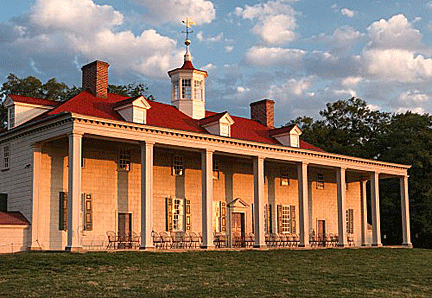
After his retirement from the presidency in 1797, guests, mostly
uninvited, besieged George Washington and his wife, Martha at Mount
Vernon.
George was 11 years old when his father, Augustine, died in 1743,
leaving the family home to his elder half brother, Lawrence, who named
it Mount Vernon after Admiral Edward Vernon, his commanding officer in
the Caribbean. George Washington spent a lot of time at this home during
his teend. Following Lawrence’s death in 1752, he leased Mount Vernon
from his widow. And when she died in 1761, Washington inherited the
property.
Between 1734 and 1799 General Washington developed Mount Vernon into one
of the finest estates of the period. His land holdings grew from 3,126
acres to slightly more than 8,000. He also doubled the size of the
modest nine-room one-and-one-half story house he inherited. He quite
successfully incorporated in his home many of the architectural
refinements which were so popular in England at the time. To support the
mansion house, he built a group of flanking service buildings. or
"dependencies," most of which still survive. The gardens and grounds
remain substantially as he designed and planted them in the late 18th
century.
Mount Vernon Maintenance and Restoration
Following the deaths of George Washington in 1799 and Martha in 1802,
Mount Vernon remained in the family for three generations. But
inheritance taxes, changing markets for agricultural products, and
throngs of visitors made it impossible for the owners to maintain Mount
Vernon. By the 1850s, the home Washington painstakingly developed was
beginning to crumble.
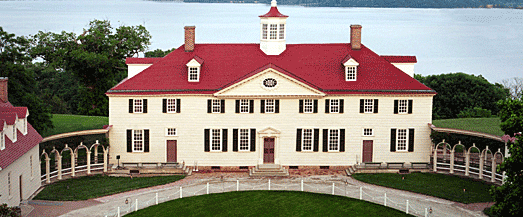
After Washington’s death, the responsibility of maintaining the estate
and acting as host to the large numbers who came from home and
abroad—some out of idle curiosity but the majority with the sincere
desire to pay their respects at the Home and Tomb of Washington –became
a heavy burden on the successive owners. Even under George Washington's
careful management his farm lands were unproductive, a condition which
intensified with the years. The buildings deteriorated and the gardens
and grounds suffered. By 1850, Mr. John A. Washington, Jr., the last
private owner, attempted, without success, to interest the State of
Virginia and the Federal Government in the purchase and preservation of
the property.
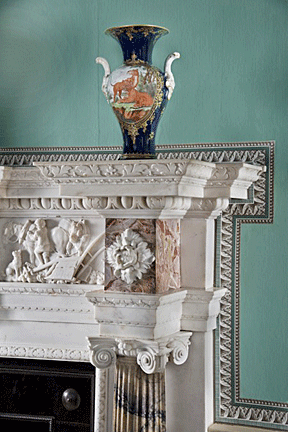 One
evening in 1853 South Carolina socialite Louise Dalton Bird Cunningham
stared out from the deck of her steamer on the Potomac and saw
Washington's home in near shambles. She wrote her daughter, Ann Pamela
Cunningham, "If the men of America have seen fit to allow the home of
its most respected hero to go to ruin, why can't the women of America
band together to save it?" Miss Cunningham ignited the preservation
movement when she wrote a letter to the editor of a South Carolina
newspaper appealing to Americans to come to the rescue of Mount Vernon.
She invited influential women from both the North and the South to serve
as the original vice-regents of the newly formed Mount Vernon Ladies'
Association, which was the first national women's organization in
America. One
evening in 1853 South Carolina socialite Louise Dalton Bird Cunningham
stared out from the deck of her steamer on the Potomac and saw
Washington's home in near shambles. She wrote her daughter, Ann Pamela
Cunningham, "If the men of America have seen fit to allow the home of
its most respected hero to go to ruin, why can't the women of America
band together to save it?" Miss Cunningham ignited the preservation
movement when she wrote a letter to the editor of a South Carolina
newspaper appealing to Americans to come to the rescue of Mount Vernon.
She invited influential women from both the North and the South to serve
as the original vice-regents of the newly formed Mount Vernon Ladies'
Association, which was the first national women's organization in
America.
By 1858 Miss Cunningham had enough money to arrange a meeting with
Washington to finalize the sale. He wasn’t convinced that a group of
women could manage Mount Vernon, and Ann Pamela Cunningham left
empty-handed. When she found the boat she expected to take her home had
already left, she returned to her uncordial host. She again engaged in
conversation with him and, with the help of his wife, was able to dispel
his fears. The Ladies' Association became the owner of Mount Vernon with
the stipulation that the Commonwealth of Virginia would assume
responsibility for the home and grounds if the Ladies' Association
floundered. Its work as the first organization in America devoted to the
preservation of a historic site had begun. The association's original
vision became the mission statement that continues today: "Ladies, the
home of Washington is in your charge—see to it that you keep it the home
of Washington. Let no irreverent hand change it; no van-dal hands
desecrate it with the fingers of progress. Those who go to the home in
which he lived and died wish to see in what he lived and died. Let one
spot in this grand country of ours be saved from change. Upon you rests
this duty." The association, which maintains a headquarters with lodging
on the Mount Vernon property, still consists of trustees, or vice
regents, who represent their home states, and a regent, or chairman. The
non-profit association still receives no federal or state financial aid
and relies solely on admission fees, revenues from food and gift sales,
and donations from foundations businesses and individuals.
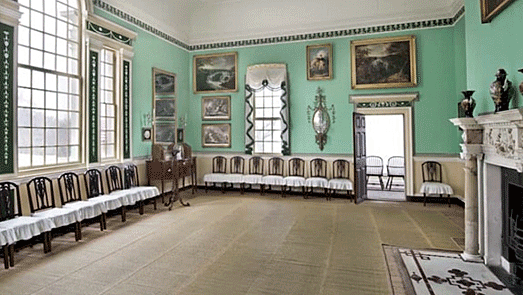
The Association refurnished the house with period pieces. Year after
year by purchase, donation. indefinite loan and bequest, it slowly
reassembled the furnishings that were at Mount Vernon in the time of
Washington.
Antiques at Mount Vernon
The home George Washington acquired in 1752 was one and half stories
with a central hall and four small rooms on the first floor. Prior to
his marriage in 1759, Washington enlarged the home to accommodate his
bride, widow Martha Custis, and her two children, John Parke Custis and
Martha Parke "Patsy" Custis. His skills as a surveyor and architect are
evident today when visitors approach Mount Vernon. Most noticeable from
the outside are the English Palladian windows and the high column
piazza, which extends the full length of the house.
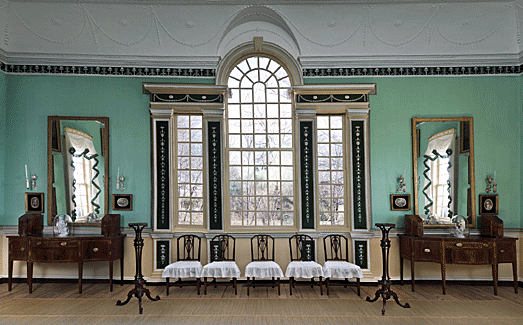
The two-story large dining room, also known as the new room, was the
last addition to the home. White chintz curtains with deep festoons of
green satin accent Palladian windows. The mantel, a gift from English
friend Samuel Vaughan, arrived in 1785 as the decoration of the room was
in progress. Vaughan also gave Washington three Worcester mantel vases,
circa 1770. Two Hepplewhite sideboards flank the windows; one is
original to the home while the other is of the period. Beneath the
windows sit nine of the original 24 chairs made for this room in 1797 by
John Aitken of Philadelphia. This handsome room was also where George
Washington received notification of his election to the presidency in
1789, and where his body lay in state before entombment a decade later.
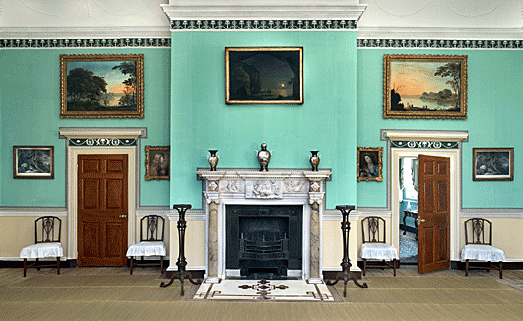
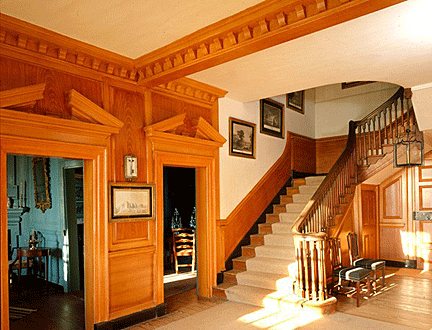 The
passage, or central hall, extends the full-length of the house from the
front door on the courtyard side to the piazza over-looking the Potomac
as was the custom in the Southern homes. During warm weather, it was the
most comfortable room in the house and the center of informal social
life for the family and its visitors. Between the doorways to the
downstairs bedroom and the dining room hangs the key to the Bastille, a
present from Gen. Lafayette in 1790 and one of the few possessions in
the home when the Ladies' Association acquired it in 1860. Over the
piazza are two plaster lions received from England in 1757. The
passage, or central hall, extends the full-length of the house from the
front door on the courtyard side to the piazza over-looking the Potomac
as was the custom in the Southern homes. During warm weather, it was the
most comfortable room in the house and the center of informal social
life for the family and its visitors. Between the doorways to the
downstairs bedroom and the dining room hangs the key to the Bastille, a
present from Gen. Lafayette in 1790 and one of the few possessions in
the home when the Ladies' Association acquired it in 1860. Over the
piazza are two plaster lions received from England in 1757.
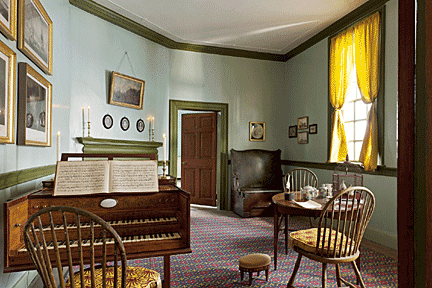 The
Little Parlor indicates the important role of music in the Washington
household. Music and dancing were the primary recreations at lively
social gatherings of family and friends. The
Little Parlor indicates the important role of music in the Washington
household. Music and dancing were the primary recreations at lively
social gatherings of family and friends.
The Front Parlor, or West Parlor, is an outstanding example of colonial
Virginia interiors that dates to the first enlargement of the home prior
to Washington's marriage. The Washington family coat of arms appears in
a carved and painted representation in the pediment over the mantel and
in a decorative panel on top of an original mirror. Washington's crest
is cast into the iron fireback of the fireplace opening. It’s one of
four firebacks he purchased in Philadelphia in 1787. Here "GW" replaces
the mullets and bars in the shield. Before the completion of the large
dining room, Washington considered this the best room of the house and
graced it with 13 family portraits.
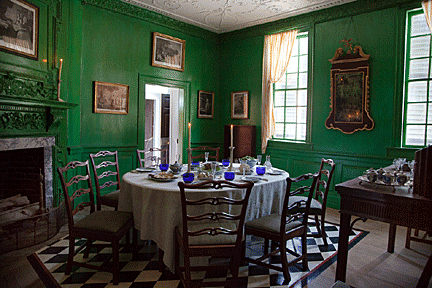 The
ornate mantel and decorated ceiling in the Small Dining Room give it a
formal air. The English sideboard table is similar to the one willed to
General Robert E. Lee and his wife, the great-granddaughter of Martha
Washington. Of the nine original Chippendale ladder-back chairs, five
are identical and belong to a numbered set. The large mahogany square
cellarette with brass lifting handles and casters is believed to have
been imported by Washington just before his marriage. The
ornate mantel and decorated ceiling in the Small Dining Room give it a
formal air. The English sideboard table is similar to the one willed to
General Robert E. Lee and his wife, the great-granddaughter of Martha
Washington. Of the nine original Chippendale ladder-back chairs, five
are identical and belong to a numbered set. The large mahogany square
cellarette with brass lifting handles and casters is believed to have
been imported by Washington just before his marriage.
The downstairs bedroom, a common feature in Virginia homes, may have
been the master bedroom until the south end of the house was completed
in 1775. Today, it houses Martha Washington's upholstered sewing chair.
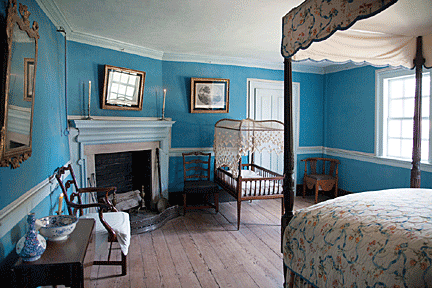 There
are five bedrooms on the second floor. The first room at the head of the
stairway is the blue bedroom, so named for the color of its woodwork.
Antiques displayed in these rooms include Martha Washington's Chinese
dressing glass and tea service, a trunk that accompanied her on her
journeys to and from the winter quarters of the Continental Army during
the Revolutionary War, and the crib given to Nelly Custis Lewis
following the birth of her first child. There
are five bedrooms on the second floor. The first room at the head of the
stairway is the blue bedroom, so named for the color of its woodwork.
Antiques displayed in these rooms include Martha Washington's Chinese
dressing glass and tea service, a trunk that accompanied her on her
journeys to and from the winter quarters of the Continental Army during
the Revolutionary War, and the crib given to Nelly Custis Lewis
following the birth of her first child.
A narrow stairway over the study leads to the master bedroom, which was
separate from the other bedrooms to give George and Martha Washington
privacy in a house overflowing with family and guests. In this room and
on this bed George Washington died on December 14, 1799. Martha
Washington's grandson, George Washington Parke Curtis, inherited the bed
and carefully preserved it. His descendants returned it to Mount Vernon
in 1908.
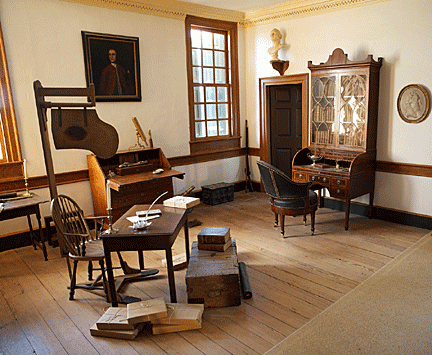 Washington's
study was where he headed immediately upon arising, which was often
before sunrise. It was here that he prepared himself for the day's
activities. Original books from his library and his presidential desk
chair were acquired through the purchase of Mount Vernon by the Ladies'
Association. At the close of his presidency, Washington disposed of his
desk and purchased the tambour secretary made by John Aitken for this
room. Washington's
study was where he headed immediately upon arising, which was often
before sunrise. It was here that he prepared himself for the day's
activities. Original books from his library and his presidential desk
chair were acquired through the purchase of Mount Vernon by the Ladies'
Association. At the close of his presidency, Washington disposed of his
desk and purchased the tambour secretary made by John Aitken for this
room.
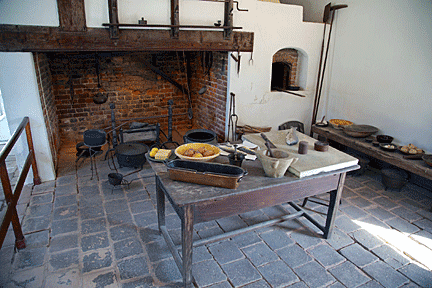 No
tour of this 500-acre estate is complete without exploring beyond the
mansion. The north lane, which leads north from the driveway circle,
contains outbuildings that include the "gardiners" house, the salt
house, the spinning house and slave quarters. The south lane contains
the kitchen, the storehouse, the stable and clerk's quarters. Four
gardens and a greenhouse cover six acres, plus there's a four-acre
pioneer farm site. No
tour of this 500-acre estate is complete without exploring beyond the
mansion. The north lane, which leads north from the driveway circle,
contains outbuildings that include the "gardiners" house, the salt
house, the spinning house and slave quarters. The south lane contains
the kitchen, the storehouse, the stable and clerk's quarters. Four
gardens and a greenhouse cover six acres, plus there's a four-acre
pioneer farm site.
Today, Mount Vernon is one of the best remaining examples of the
plantations around which centered the highly developed social and
economic life of the South in 18th-century America. Visitors can inspect
a dozen buildings. While the mansion is of prime interest and
importance, no one should leave the estate, particularly on their first
visit, without making a pilgrimage to George Washington’s Tomb at the
foot of the graveyard enclosure. On a stone tablet above the gate.
there's a modest inscription "Within this enclosure rest the remains of
Gen. George Washington."
And while Mount Vernon may have been the
first historic house to be saved in the United States, it's by far not
the last. Hundreds of historic house museums around the country can
thank Pamela Cunningham for beginning a tradition that has lasted for
nearly two centuries.
<
Back to More Antiques to View
Next Article > |
